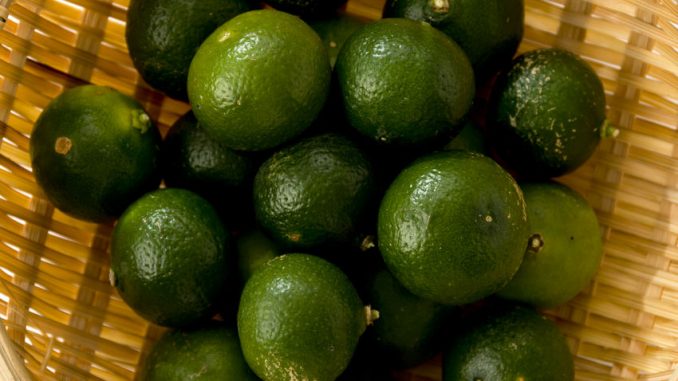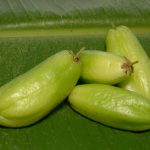
Shiikuwasa is a citrus fruit indigenous to the Ryukyu Islands. It is primarily grown in Okinawa and the Kagoshima prefecture (Kyushu Island) with the scientific name of Citrus depressa Hayata although this may well change as further details relating to the fruit become more well known. It was known in the early years as Citrus pectinifera which has now been superseded. The fruit as with all citrus is in the Rutaceae family.
Its other names are Flat lemon and Hirami lemon. You may also see it called the Taiwan tangerine, thin-skinned flat lemon and shequasar. It is not calamondin as it is sometimes called in error.
It is a small flat (oblate) lemon that comes from a tree of 3 to 5 metres in height. It is highly depressed at both the basal and apical ends. The fruit has a thin aromatic peel which is commonly used to flavour food.
The juice is extremely sour and makes a fine beverage soft drink. Chefs garnish dishes with the fruit as they would a lemon.
The fruit is commercially produced in southwest Japan and in the northern region of Okinawan island. Another fruit Citrus tachibana is also grown on the island where it has been crossbred. The varieties grown are ‘Izumi kugani’,’Katsuyama kugani’, and ‘Ogimi kugani’ (Asikin et al., 2015). The fruit is not to be found anywhere else in Asia although it deserves to be more widely grown.
Fruit Components In Shiikuwasha
The fruit is rich in flavonoids and is a good source of pectin.
The polymethoxyflavones are especially rich in this fruit (Terahara, 2015). These are a trio of compounds called nobiletin, tangeretin and sinensetin. Nobiletin (5,6,7,8,3′,4′‐hexamethoxyflavone) is the key compound. Such compounds are extracted using supercritical fluid extraction (Lee et al., 2010; Asikin et al., 2012b)).
The peel contains most of the componentry of value. This includes synephrine which is considered to improve fat metabolism (Ohta, 1982) and raise metabolic rate. There is an alkaloid called citracridone that is an antispasmodic.
The peel oil has a significant antioxidant content which declines as the fruit ripens. presumably these are precursors of other key compounds (Asikin et al., 2015).
The main volatiles are alpha-pinene, gamma-terpinene and linalool (Asikin et al., 2012a). Thymol is present but its level depends on how well its is extracted. The limonene content is lower than in other citrus peels although that is no reflection on absolute quality of flavour.
The fruit’s rind contains pectin (4.1% fresh weight) which is high methoxyl in character and probably ideal for jam manufacture. Its structure is considered simpler than other pectins.
Any beverages need sugar added to overcome the extremely sour taste of the juice.
In response to maximising the health potential of the juice, different cultivars of the fruit have been examined as well as how peeling affects the quality of the fruit. One variety Izumi kugani had a lower activity but contained more vitamin C (ascorbic acid).
The pomace from fruit processing could also generate some interesting new functional compounds using lactic acid bacteria (Kimoto-Nira et al., 2018). The lactic acid bacteria are used to ferment a wide variety of foods such as vegetables and cheeses which in their own right have probiotic benefits. Given that pomace is often widely discarded it should be possible to extract some very useful compounds such as nobiletin. The pulp could also be a high valuable source of essential oils (Asikin et al., 2018).
Health Benefits Of Shiikuwasha
The health benefits associated with this fruit are likely to be common to all citrus fruits. The pectin for example would make a typical soluble dietary fibre if extracted.
The polymethoxy flavonoids are commonly found in many citrus fruits. They are all known to exert anti-inflammatory effects (Murukami et al., 2000) as well as having other benefits (Tripoli et al., 2007; Li et al., 2009).
The peel extract has been tested as an anti-obesity agent for treating obese mice. Feeding the extract to the fat mice lowered their body weight and levels of white adipose tissue. The most pertinent effect was the regulation of genes involved in lipogenesis or fat production in the white adipose tissue (Lee et al., 2011).
Nobiletin has been shown to suppress human gastric cancer cell lines (Yoshimizu et al., 2004). It is likely that increasing use will be made of peel extracts in the treatment of certain types of cancer given their efficacy.
References
Asikin, Y., Fukunaga, H., Yamano, Y., Hou, D. X., Maeda, G., & Wada, K. (2014). Effect of cultivation line and peeling on food composition, taste characteristic, aroma profile, and antioxidant activity of Shiikuwasha (Citrus depressa Hayata) juice. Journal of the Science of Food and Agriculture, 94(12), pp. 2384-2392. (Article)
Asikin, Y., Kawahira, S., Goki, M., Hirose, N., Kyoda, S., & Wada, K. (2018). Extended aroma extract dilution analysis profile of Shiikuwasha (Citrus depressa Hayata) pulp essential oil. Journal of food and Drug Analysis, 26(1), pp. 268-276.
Asikin, Y., Maeda, G., Tamaki, H., Mizu, M., Oku, H., & Wada, K. (2015). Cultivation line and fruit ripening discriminations of Shiikuwasha (Citrus depressa Hayata) peel oils using aroma compositional, electronic nose, and antioxidant analyses. Food Research International, 67, pp. 102-110. (Article)
Asikin, Y., Taira, I., Inafuku, S., Sumi, H., Sawamura, M., Takara, K., & Wada, K. (2012a). Volatile aroma components and antioxidant activities of the flavedo peel extract of unripe Shiikuwasha (Citrus depressa Hayata). Journal of Food Science, 77(4), C469-C475. (Article)
Asikin, Y., Taira, I., Inafuku-Teramoto, S., Sumi, H., Ohta, H., Takara, K., & Wada, K. (2012b). The composition of volatile aroma components, flavanones, and polymethoxylated flavones in shiikuwasha (Citrus depressa Hayata) peels of different cultivation lines. Journal of Agricultural and Food Chemistry, 60(32), pp. 7973-7980
Asikin, Y., Tomimura, A., Yamakawa, Y., Maeda, G., Hirose, N., Oku, H., & Wada, K. (2014, November). Extraction method influenced physical, aroma, and antioxidant profiles of Shiikuwasha (Citrus depressa Hayata) pulp essential oil. In III International Symposium on Citrus Biotechnology 1135 pp. 61-72.
Kimoto‐Nira, H., Moriya, N., Nogata, Y., Sekiyama, Y., & Toguchi, Y. (2019). Fermentation of Shiikuwasha (Citrus depressa Hayata) pomace by lactic acid bacteria to generate new functional materials. International Journal of Food Science & Technology, 54(3), pp. 688-695 (Article)
Lee, Y. H., Charles, A. L., Kung, H. F., Ho, C. T., & Huang, T. C. (2010). Extraction of nobiletin and tangeretin from Citrus depressa Hayata by supercritical carbon dioxide with ethanol as modifier. Industrial Crops and Products, 31(1), pp. 59-64. https://doi.org/10.1016/j.indcrop.2009.09.003
Lee, Y. S., Cha, B. Y., Saito, K., Choi, S. S., Wang, X. X., Choi, B. K., … & Woo, J. T. (2011). Effects of a Citrus depressa Hayata (shiikuwasa) extract on obesity in high-fat diet-induced obese mice. Phytomedicine, 18(8-9), pp. 648-654
Li, S., Pan, M. H., Lo, C. Y., Tan, D., Wang, Y., Shahidi, F., & Ho, C. T. (2009). Chemistry and health effects of polymethoxyflavones and hydroxylated polymethoxyflavones. Journal of Functional Foods, 1(1), pp. 2-12.
Miyagi, K., Fujise, T., Koga, N., Wada, K., Yano, M., Ohta, H. (July 2008). The synephrine content of Shiikuwasha (Citrus depressa HAYATA) fruit: Analytical method and change during fruit growth. Planta Medica. 74 (9): PC120. doi:10.1055/s-0028-1084638. ISSN 1439-0221.
, ,, et al. (2000) Inhibitory effect of citrus nobiletin on phorbol ester‐induced skin inflammation, oxidative stress, and tumor promotion in mice. Cancer Res. ; 60: pp. 5059–66 (Article)
Ohta, H. (2012). Physiological Function and Variety Differentiation of Shiikuwasha Fruit (Citrus depressa, Hayata) Produced in Okinawa. Nippon Shokuhin Kagaku Kogaku Kaishi. 59 (7) pp. 357–362. doi:10.3136/nskkk.59.357. ISSN 1881-6681. (Article)
Tamaki, Y., Konishi, T., Fukuta, M., & Tako, M. (2008). Isolation and structural characterisation of pectin from endocarp of Citrus depressa. Food Chemistry, 107(1), pp. 352-361. (Article)
Terahara, N. (2015). Flavonoids in foods: a review. Natural Product Communications, 10(3), 1934578X1501000334.
Tripoli, E., La Guardia, M., Giammanco, S., Di Majo, D., & Giammanco, M. (2007). Citrus flavonoids: Molecular structure, biological activity and nutritional properties: A review. Food chemistry, 104(2), 466-479.
Wang, L., Wang, J., Fang, L., Zheng, Z., Zhi, D., Wang, S., … & Zhao, H. (2014). Anticancer activities of citrus peel polymethoxyflavones related to angiogenesis and others. BioMed Research international, 2014. (Article)
Yoshimizu, N., Otani, Y., Saikawa, Y., Kubota, T., Yoshida, M., Furukawa, T., … & Sato, T. (2004). Anti‐tumour effects of nobiletin, a citrus flavonoid, on gastric cancer include: antiproliferative effects, induction of apoptosis and cell cycle deregulation. Alimentary Pharmacology & Therapeutics, 20, pp. 95-101.


This is a very informative article and should benefit many people all over the world. I have heard of a derivative seedling of Shiikuwasa called Kugani that has similar good health characteristics as Shiikuwasa but much sweeter and is being consumed as fresh fruit. If you have any information on Kugani I would appreciate learning about it.
Thank you